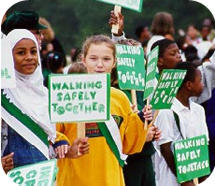|
Taking
back the streets for pedestrians
HSRC
documents National Walk Our Children to School Day — A movement catching
fire around the country
story
contents:
introduction | the partnership's formation
| pedestrians find a voice | finding
out who walked

"It
was a miniature United Nations at Indian Creek Elementary in Clarkston,
Ga., but at least their feet spoke the same language." |
Introduction
In 1995 the Highway Safety Research Center began a project that strived
to increase walking in the United States, and reduce the number of deaths
and injuries to pedestrians. Little did the staff at HSRC know that
this would be their first involvement with what would someday become
an inspiring movement known as National Walk Our Children to School
Day.
On October 6, 1999, approximately 300,000 children, community leaders
and parents walked to school to promote physical activity and pedestrian
safety. The 2000 event promises to be even larger. On Wednesday, October
4, 2000, National Walk our Children to School Day will join Great Britain,
Canada, Australia and New Zealand to create the first ever International
Walk to School Day. Information about this event can be found on a website
maintained at HSRC at: www.iwalktoschool.org
top of page
The Partnership's Formation
The initial HSRC "pedestrian project" was funded by the National Highway
Safety Administration and the Federal Highway Administration but many
other private, federal, state and local organizations concerned with
different aspects of walking are part of this movement. In the '90s,
these organizations came together to form the Partnership
for a Walkable America.
Before long, National Walk Our Children to School Day was created and
the Partnership launched their first event on September 4, 1997 in Chicago.
That day, Chicago schoolchildren walked to school together along with
Mayor Daley. A similar event was held in Los Angeles with Mayor Richard
Riordan.
Partnership members who helped launch the 1997 event include the National
Safety Council, WALKING Magazine, the National Highway Traffic Safety
Administration, the Institute of Transport Engineers, the National Association
of Governors' Highway Safety Representatives, the National SAFE KIDS
Campaign, the Campaign to Make America Walkable, the city of Chicago,
and HSRC. Over the last couple of years, the movement has gained considerable
momentum.
top of page
Pedestrian's Find
a Voice
Giving power to pedestrians in the early stages of this project wasn't
simple. When HSRC first began working with health and safety experts
and transportation engineers on how to promote safe walking, many people
simply didn't consider themselves pedestrians or think about whether
their walking route was safe. "Often times, if you drive a car, you
know you're a driver but if you walk somewhere during the day, you don't
necessarily realize you've just been a pedestrian," Marchetti said.
In the early stages of the Partnership, it was immediately apparent
that pedestrians needed a way to identify problems on their routes and
to find solutions. So HSRC worked with the Partnership to create a checklist
that walkers could fill out during their travels. Questions focused
on the safety of the route, driver behavior, how they enjoyed the walk
and how the exercise made them feel. Children and parents who found
problems during the walk to school were encouraged to submit their walkability
checklists to their public works department or to community leaders.
top of page
Finding Out Who Walked
To evaluate the effectiveness of these walks, HSRC began compiling a
list of the schools that had requested materials about the 1998 event.
They were shocked and excited by what they found. Lauren Marchetti,
Manager of Public Information Programs at HSRC said, "Once we began
calling we realized what we had gotten ourselves into. National Walk
Our Children to School Day was much bigger than anyone had ever thought."
The calls took weeks but after it was all over, HSRC staff discovered
that more than 170,000 kids and parents from 58 communities across the
United States and Canada had walked to school on September 23, 1998.
The National Walk Our Children to School Day booklet put together by
HSRC staff documenting these 1998 walks further fueled the movement.
Once communities realized that they were not alone in their concern
for pedestrian safety and physical fitness, the goal of creating a walkable
America seemed more attainable, Marchetti said. "Schools walked one
year and then the next year they had sidewalks. To see that kind of
dramatic change in one year means these communities are really doing
some impressive work," she said.
HSRC staff plan to continue documenting the National Walk Our Children
to School Day movement through a grant from the U.S. Department of Transportation.
"We expect that the year 2000 event will bring great things," Marchetti
said.
top
of page
|

